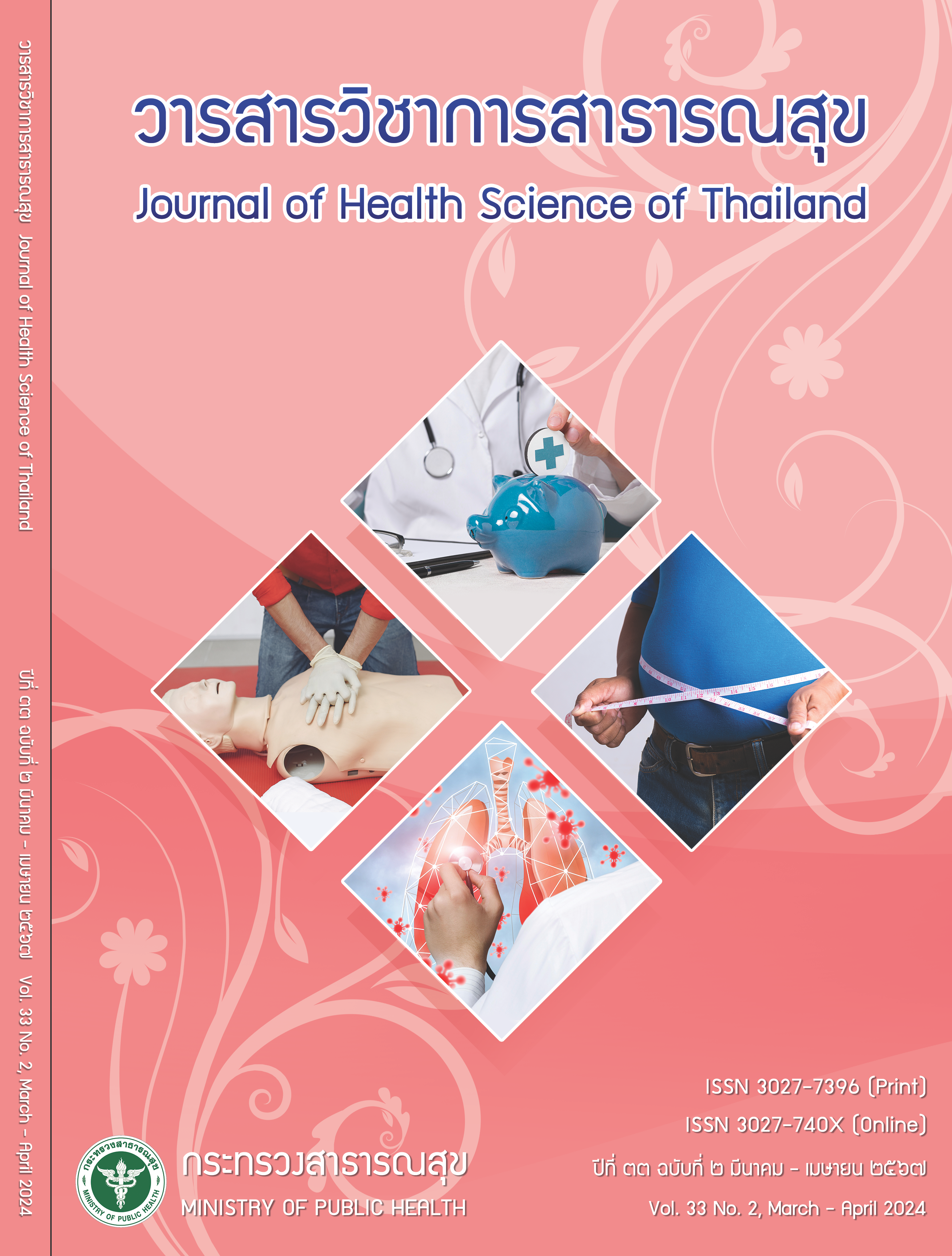Effects of Applied Psychosocial Treatment Program in Substance Abuse Patients, Kong Krailat District, Sukhothai Province
Keywords:
emotional quotient, substance use disorder, applied psychosocial treatment programAbstract
This study employed a prospective observational design to examine the efficacy of applied psychosocial treatment program with substance use disorder in Kong Krailat Hospital, Sukhothai province. The samples consisted of 134 substances users attending outpatient clinic at the hospital during January to July 2023. The participants underwent a 4-month applied psychosocial treatment program. Data were collected through interviews on substance use history, the national drug abuse report form and emotional quotient assessment; and the data were analyzed by using descriptive analysis and Chi-square test. The results revealed that the majority of samples were male, aged 31-40 years, single, highest education level of high school, working as general laborers, and monthly incomes below 3,000 baht. Nearly two-thirds of participants started using substance before the age of 20 (63.4%), with peer influence (44.0%) and curiosity (28.4%) being the main reasons. Results from the intervention treatment program showed that 93.7% of participants completed the 4-month program, with 76.1% were able to abstain from substance use for 3 months. Moreover, the participants showed improved emotional intelligence levels with most falling within the normal to high range. Age, education level, monthly income, and reasons for the initial substance use were positively correlated with the ability to abstain from substance use for 3 months. The applied psychosocial treatment program combined with emotional intelligence enhancement was found to be effective in treating substance abuse patients in a small, resource-limited community hospital.
Downloads
References
ชลอวัฒน์ อินปา, ชลภัชร ลันสุชีพ, อาทิตยา ภัทรมนัส. แผน ยุทธศาสตร์ด้านการบำบัดรักษาและฟื้นฟูผู้ป่วยยาเสพติด ประจำปีงบประมาณ พ.ศ. 2564 – 2566 [อินเทอร์เน็ต]. [สืบค้นเมื่อ 30 ส.ค. 2566]. แหล่งข้อมูล: https://ncmc. moph.go.th/home/upload/web_download/rptk5fmp8q8sk0soko.pdf
กรมการแพทย์ กระทรวงสาธารณสุข. แนวทางการคัดกรอง การประเมินความรุนแรง การบำบัด การฟื้นฟูสมรรถภาพ ผู้ติดยาเสพติดสำหรับศูนย์คัดกรอง สถานพยาบาลยาเสพติด และสถานฟื้นฟูสมรรถภาพผู้ติดยาเสพติดตามประมวล กฎหมายยาเสพติด [อินเทอร์เน็ต]. 2565 [สืบค้นเมื่อ 30 ส.ค. 2566]. แหล่งข้อมูล:https://www.chiangmaihealth. go.th/document/221101166727744069.pdf
ชลอวัฒน์ อินปา. แผนยุทธศาสตร์ด้านการบำบัดรักษาและ ฟื้นฟูผู้ติดยาเสพติด พ.ศ. 2566-2570. กรุงเทพมหานคร. องค์การสงเคราะห์ทหารผ่านศึก; 2565.
สกุลรัตน์ อุษณาวรงค์, ขนิษฐา นันทบุตร, ประยุทธ ชูสอน, รัตนาภรณ์ อัดธรรมรัตน์, ฉวี เย็นใจ, วรรณภา นิวาสะวัต, และคณะ. การศึกษาสภาพปัญหาการติดยาและสารเสพติด ในจังหวัดขอนแก่น. วารสารวิจัย มข. 2540;2(2):101-11.
วาสนา พัฒนกำจร.ปัจจัยที่สัมพันธ์กับพฤติกรรมการใช้ยาบ้า ของนักเรียนนักศึกษาในจังหวัดราชบุรี. วารสารสมาคมจิตแพทย์แห่งประเทศไทย 2541;43(4):345-57.
ภัทราภรณ์ กินร, อภิชาติ เรณูวัฒนานนท์, วันเพ็ญ ใจปทุม. องค์ความรู้พื้นฐานในการบำบัดฟื้ นฟูสมรรถภาพผู้ติดยาและ สารเสพติดแบบผู้ป่วยนอกตามรูปแบบ Matrix program. ปทุมธานี: สถาบันบำบัดรักษาและฟื้ นฟูผู้ติดยาเสพติดแห่งชาติบรมราชชนนี; 2563.
อมรรัตน์ บางพิเชษฐ์. ปัจจัยทีสัมพันธ์กับการสามารถติดตามผู้เข้ารับการบำบัดสารเสพติดแบบจิตสังคมบำบัด (Modified Matrix program) ได้ครบ 1 ปี. วารสารสวนปรุง 2557;30: 48-57.
อารี สุภาวงศ์. ประสิทธิผลของการบำบัดรักษาผู้ป่ วยยาเสพติดตามรูปแบบจิตสังคมบำบัดแบบประยุกต์ โรงพยาบาล ทุ่งสง. วารสารพยาบาลสงขลานครินทร์ 2559;36:160-70.
มงคล ลือชูวงศ์. ปัจจัยที่มีความสัมพันธ์กับความฉลาดทาง อารมณ์ของผู้ป่วยใช้สารแอมเฟตามีน อำเภอกงไกรลาศ จังหวัดสุโขทัย 2566 [อินเทอร์เนต]. [สืบค้นเมื่อ 30 ส.ค. 2566]. แหล่งข้อมูล: kklh.go.th/archives/4963
กลุ่มงานจิตเวชและยาเสพติด รพ. กงไกรลาศ. คู่มือบำบัด รักษาสารเสพติดแบบผู้ป่ วยนอกรูปแบบประยุกต์การบำบัด แบบความคิดและพฤติกรรม Matrix program 2565 [อินเทอร์เน็ต]. [สืบค้นเมื่อ 30 ส.ค. 2566]. แหล่งข้อมูล: kklh.go.th/archives/4961
สำนักพัฒนาสุขภาพจิต กรมสุขภาพจิต กระทรวงสาธารณสุข. แบบประเมินความฉลาดทางอารมณ์สำหรับผู้ใหญ่ (อายุ 18-60 ปี ) 2546 [อินเทอร์เนต]. [สืบค้นเมื่อ 30 ส.ค. 2566]. แหล่งข้อมูล: https://dmh-elibrary.org/items/ show/42
กนกลักษณ์ ศิริรุ่งวัฒนากุล. ประสิทธิผลและปัจจัยที่มีผลต่อ การบำบัดรักษาผู้ติดยาและสารเสพติดโดยใช้รูปแบบการ บำบัดความคิดและพฤติกรรมแบบประยุกต์ของโรงพยาบาล สวรรค์ประชารักษ์. สวรรค์ประชารักษ์เวชสาร 2562;16(1): 23-33.
สวัสดิ์ อุ่นใจ, กิจวัฒ นาถวิล, ญาธษา พันวิไล, สุกัญญา กาญจนบัตร, มานพ คณะโต. การประเมินการใช้แมทริกซ์ โปรแกรมในการบำบัดรักษาผู้ติดยาเสพติดของโรงพยาบาล สังกัดสำนักงานปลัดกระทรวงสาธารณสุข 7 จังหวัด ภาคตะวันออกเฉียงเหนือตอนบน. วารสารการพัฒนาสุขภาพชุมชน มหาวิทยาลัยขอนแก่น 2560;4:661-81.
เฉลิม โพธานารักษ์. อัตราการหยุดเสพของผู้ป่วยสารเสพติด หลังจากเข้าร่วมการบำบัดรักษาด้วยโปรแกรมกาย จิต สังคม บำบัดแบบประยุกต์ ในผู้ป่วยนอก โรงพยาบาลแม่อาย จังหวัดเชียงใหม่. วารสารสาธารณสุขศาสตร์ มหาวิทยาลัย นเรศวร 2565;4(2):33-46.
ธนิตา หิรัญเทพ, อุมาพร อุดมทรัพยากุล, รณชัย คงสกนธ์. ปัจจัยที่สัมพันธ์กับการไม่เสพยาเสพติดซ้ำในผู้เข้ารับการ บำบัดในระบบบังคับบำบัด. วารสารสมาคมจิตแพทย์แห่ง ประเทศไทย 2556;58(2):157-64.
Downloads
Published
How to Cite
Issue
Section
License
Copyright (c) 2024 Ministry of Public Health

This work is licensed under a Creative Commons Attribution-NonCommercial-NoDerivatives 4.0 International License.







